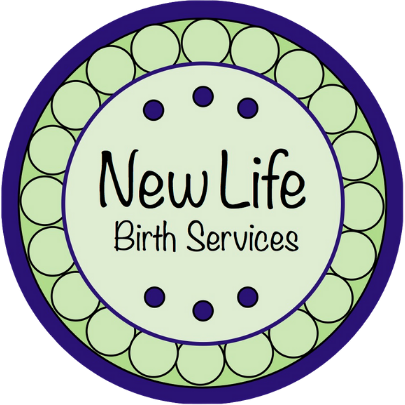The Happiest Baby on the Block: New Life Birth Services Book Club
Written by Birth Doula Jaelan Mincey
“The Happiest Baby on the Block”, written by Dr. Harvey Karp, uncovers how to calm practically all babies. Through the book, he instructs parents on how to recreate the “womblike” atmosphere that new babies still desire. He also discusses the “calming reflex”, and teaches five methods to turn on your baby’s calming reflex switch. Lastly, he teaches the “cuddle cure”, which is how to combine the 5 S’s to calm even the most unsettled baby. I like this book because it covers an area I find many parents fail to plan for: the fourth trimester.
Dr. Karp begins by sharing that all babies cry. Crying is how babies get their parents’ attention to meet their basic human needs. This is also why baby cries can feel so alarming to adults. This reaction is biology’s way of creating a sense of urgency. But what about colic? Colic is diagnosed by the rule of threes, meaning that a baby has colic if he cries at least: three hours a day, three days a week, for three weeks in a row. Dr. Karp debunks 5 of the most common situations believed to cause colic and explains that the most believable reason babies are colicky is the missing fourth trimester.
This means that essentially, babies are born about 3 months too soon. It’s hypothesized that because of the size of the newborn brain, it’s mandatory to give birth to babies before they’re ready for much of the outside world. This is why it’s so important to create a womb-like atmosphere for babies, outside of the womb. While in utero, babies are lulled to sleep by the sound of their mother’s breath, a cozy and tight warm space, and near-constant movement.
Creating a womb-like atmosphere helps turn on your baby’s calming reflex switch. Every baby is born with this switch. By keeping the baby tightly confined in a swaddle or swing, and by adding in rhythm through shushing or soft bouncing, you can recreate the feeling that the baby is back in the womb. It’s explained that every baby is born with the calming switch because it’s vital for survival. Centuries ago, our ancestors might not survive if they couldn’t calm their crying babies for fear of predators lurking.
So why are colicky babies more prevalent in modern-day American culture? Dr. Karp believes that perhaps it has stemmed from the parenting methods employed over the past couple of centuries. For example, many Americans believe that it’s possible to “spoil” a newborn baby by holding them too much, so babies are left to entertain themselves, distant from their parents. Karp disagrees with the notion that babies are spoiled by attention and further explains that mothers in less developed nations tend to hold or wear their babies nearly 24 hours a day, breastfeed on demand, and respond to their baby’s cries in about 10 seconds or less. It could be that as we moved into more “civilized” times, we lost the instinct to care for our babies in this way even though, biologically, babies haven’t lost the need to have the calming reflex activated.
To activate the calming reflex, parents turn to the 5 S’s: swaddling, side/stomach lying, shushing, swinging, and sucking. Dr. Karp explains that these five methods are extremely effective, but they must be done with the proper technique and vigor. Creating the cuddle cure starts with swaddling, then moves to side-lying. This sets the foundation for adding shushing, swinging, and sucking to create the perfect recipe for calming baby.
Dr. Karp gives the following tips for the perfect 5 S’s:
To swaddle effectively, keep the baby’s arms straight down by their side, and with each fold of the swaddle, tuck and snug the blanket as tightly as possible. Be careful and watch for loosening of the swaddle.
For side-lying, keep the baby rolled at least a little bit toward his stomach, and it’s essential to make sure the baby isn’t hungry before placing him into this position.
Shushing a baby shouldn’t be a quiet affair. “Shhh” louder than your baby’s cries, or if you’re using a machine be sure to place it one to two feet away from the baby’s head so it’s loud enough to trigger the calming reflex.
For screaming babies, gentle swinging will likely not do the trick. Move a fussy baby in quick, “shiver-like” wiggles. Slow movements may keep the baby asleep, but they do almost nothing to calm a crying infant. Be sure to support the baby’s head and neck, but hold his head a little loosely so it can jiggle in your hands.
If your baby refuses to take a pacifier, try to calm him first. Also, note that it’s best if pacifiers aren’t introduced for 2 to 3 weeks after birth due to promote breastfeeding. For parents wishing to avoid a pacifier, a finger may be used.
In conclusion, The Cuddle Cure is a combination of all of the 5 S’s and is the piece Dr. Karp believes is missing from modern-day parenting. By making a layer cake of these 5 techniques, babies are calmed and their need for a womb-like atmosphere is satisfied. No parent wants to see their child in uncontrollable discomfort, and the cuddle cure might just be the ticket. I appreciate Dr. Karp’s methods for really taking it back to basics when it comes to infant soothing. There are no fancy gadgets needed and it’s not time-consuming. Learning The Cuddle Cure is as fuss-free as parenting can get.

